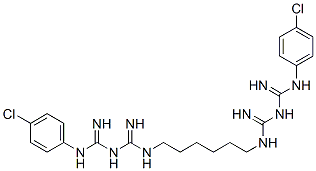Chlorhexidine Diacetate is white or almost white, microcrystalline powder
Chlorhexidine Diacetate is a disinfectant and topical anti-infective agent used also as mouthwash to prevent oral plaque. Chlorhexidine is a cationic broad-spectrum antimicrobial agent belonging to the bis(biguanide) family. Its mechanism of action involves destabilization of the outer bacterial membrane. It is effective on both Gram-positive and Gram-negative bacteria, although it is less effective with some Gram-negative bacteria. It has both bactericidal and bacteriostatic mechanisms of action. Aqueous solutions of chlorhexidine are most stable within the pH range of 5-8. Above pH 8.0 chlorhexidine base is precipitated and in more acid conditions there is gradual deterioration of activity because the compound is less stable. Chlorhexidine is used primarily as a topical antiseptic/disinfectant in wound healing, at catheterization sites, in various dental applications and in surgical scrubs.
antimicrobial agent in, e.g., cosmetic and disinfection solutions, eye drops, uterine antiseptics, toothpaste, mouthwash, hand and
wound deansers.
These Secondary Standards are qualified as Certified Reference Materials. These are suitable for use in several analytical applications including but not limited to pharma release testing, pharma method development for qualitative and quantitative analyses, food and beverage quality control testing, and other calibration requirements.
ChEBI: Chlorhexidine acetate is the acetate salt of chlorhexidine. It is a disinfectant used for bacterial control in hospital, agricultural and domestic environments. It has a role as an antibacterial agent, an antiinfective agent, an antifungal agent and an antifouling biocide. It contains a chlorhexidine.
Pharmaceutical secondary standards for application in quality control, provide pharma laboratories and manufacturers with a convenient and cost-effective alternative to the preparation of in-house working standards.



